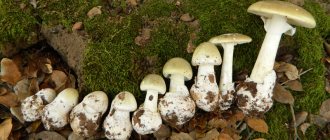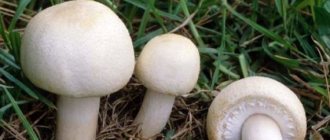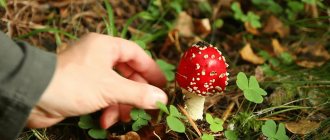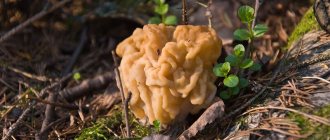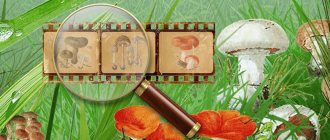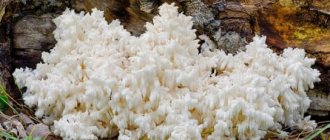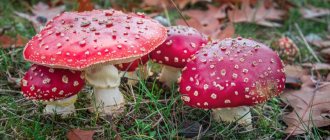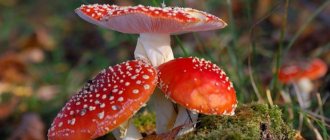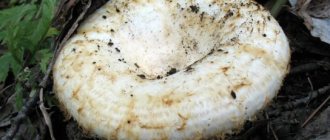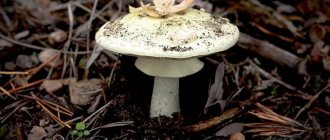Pale toadstool (green or white fly agaric) is a deadly poisonous mushroom from the fly agaric genus, rarely found in central Russia, more often in the southern regions. Not only the mushroom itself is poisonous, but also its juice and spores. It is usually located in groups (less often separately) on the surface of the roots of deciduous trees, but it is also found in mixed forests. Toadstool is most widely represented from late summer until the first autumn frosts.
Source: depositphotos.com
Distinctive features of the pale grebe
At first glance, toadstool is very similar to russula or champignon, but this is not so; the mushroom has some structural features.
So, when unripe, it has an ovoid shape and is completely surrounded by a film. The hemispherical hat can be from 5 to 15 cm in diameter. The color can be from olive to grayish, being darker in the center and lighter at the edges. This mushroom has fleshy white flesh with the smell of raw potatoes.
The main feature of the toadstool is the presence of a girdle on the stem, which is not found in edible mushrooms. In addition, the lower part of its leg is surrounded by a membranous sac 3-5 cm in diameter - the volva. By these two signs you can distinguish the toadstool from its edible counterparts.
Where does the toadstool grow?
The pale grebe loves moisture very much and after rain a huge number of them appear. It appears quite rarely in countries with arid climates, as well as in areas characterized by dry, hot weather. The mushroom prefers mixed and deciduous forests, but this does not mean that it cannot be found in coniferous forests. Mushrooms reach their peak of development from the second half of August until October.
The birthplace of the pale grebe is Europe, after which it penetrated into Asia and Africa, spreading throughout America and Australia. In fact, the pale grebe is not so common, but nevertheless there are many places that it prefers to live. The pale grebe feels best next to oaks, chestnuts, birches, maples, lindens, hazels, beeches, and elms. But it was also noticed next to conifers: fir trees and pines. The pallid grebe is also now spreading throughout the world; recently it has become noticeable that it is finding trees as partners that were previously unusual for it. For example, the pale grebe is now doing quite well in Iran, where it grows next to hazelnuts, and has even been seen in Algeria, where it uses eucalyptus.
The effects of toadstool venom on the body
Toadstool contains two types of toxins that have a destructive effect on human organs: phalloidin and alpha-amanitin. They have different speeds of action, but are highly toxic. At the same time, the poison of the toadstool is not destroyed under the influence of high temperatures, freezing, drying, vinegar or alcohol.
Once ingested, toxins cannot be digested in the intestines. They enter the liver, affecting its cells. In addition, intoxication is accompanied by the following pathologies:
- metabolic disease;
- drop in blood glucose levels;
- violation of the integrity of blood vessels;
- fatty transformation of organs;
- significant internal hemorrhages;
- disturbances in the activity of the central nervous system;
- cerebral edema.
Folk signs
It is very important to understand that folk signs are not always able to help you determine whether a mushroom is poisonous or not. There are several common misconceptions that can really cost the life of a careless mushroom picker:
- All poisonous mushrooms have an unpleasant smell, but edible ones have a pleasant smell. Pale grebe is very often similar in smell to champignons, and some of the species have no smell at all, so this sign cannot be considered correct.
- Insect larvae never live in poisonous mushrooms. In fact, this is not true; the larvae of some insects feel quite comfortable even in a poisonous mushroom.
- All mushrooms, if they are young, can be eaten. Let's not judge all mushrooms, but toadstool is deadly at any age.
- If you make a decoction of a poisonous mushroom and put silver in it, the silver will definitely turn black. The range of toxic substances contained in various poisonous mushrooms is very diverse. It is possible that some mushrooms affect silver in this way, but this does not mean that this remedy can be considered the correct way to find out whether a mushroom is poisonous or not.
Symptoms of intoxication
Symptoms of toadstool poisoning appear some time after ingestion. Often a person begins to feel unwell after 8-12 hours, in especially severe cases - after 2-3 days. The period of detection of the first symptoms depends on the amount and concentration of the toxic substance in the body.
Intoxication of the body with the poison of the toadstool occurs in four stages, each of which has characteristic signs:
- Latent period. The duration of this stage ranges from 6 to 9 hours, in rare cases reaching 15-16 hours. A person is characterized by nonspecific signs of the development of the disease: malaise, weakness, general weakness of the body. Most often they appear 8-10 hours after taking poisonous mushrooms.
- Period of acute gastroenteritis. This phase of the disease lasts about 2-4 days. It is characterized by the following symptoms:
- sudden excessive vomiting of food or bile;
- persistent nausea;
- spasmodic pain in the abdomen and colic in the intestines;
- diarrhea mixed with blood with stool frequency up to 25 times a day;
- thirst, dry mouth as a result of an imbalance in the water balance in the body, which cannot be quenched due to recurrent vomiting;
- dizziness, weakness, headache;
- decreased blood pressure;
- tachycardia;
- cramps of the calf muscles as a result of the loss of large amounts of chlorine;
- decrease in the amount of urine excreted or its absence;
- blurred vision.
In case of severe poisoning with toadstool, at this stage the activity of the cardiovascular system may be impaired.
- A period of imaginary recovery. Spasmodic pain in the abdomen, nausea and vomiting subsides, and health improves. In this case, a biochemical blood test indicates serious disturbances in the functioning of the liver. Toxins continue to spread throughout the body, impairing the functioning of organs and systems. The improvement stage lasts about a day, but in case of severe intoxication it may not be observed at all. The disease immediately moves on to the next phase of development.
- Period of acute renal and liver failure. Clinical manifestations of this stage depend on the stage of liver dysfunction and are expressed by the following symptoms:
- yellowing of the skin, mucous membranes of the eyes and mouth;
- resumption of intestinal colic and diarrhea;
- darkening of urine;
- the occurrence of heaviness and pain in the right hypochondrium;
These symptoms indicate kidney damage, pathological enlargement of the liver and disruption of its functioning.
Poisonous mushroom against cancer
In laboratory conditions, German scientists managed to stop the growth of cancer cells:
- mammary gland;
- colon;
- pancreas;
- bile ducts.
One injection of antibodies is enough to suppress tumor growth in experimental mice. It has been established that the poison does not harm the liver and other organs of animals. Preparations based on toadstool suppress tumor growth in experimental mice. Treatment of other types of cancer, such as leukemia and lymphoma, using amanitin is a task for German scientists in the near future.
First aid
If a person accidentally ingests a toadstool, a person needs immediate, highly qualified medical care. When the first signs of intoxication develop, it is necessary to call an ambulance.
Before the doctor arrives, you must try to help the patient. First aid for poisoning with toadstool consists of implementing a sequence of actions to eliminate toxins from the body. To do this you need:
- Rinse the victim's stomach. A person with signs of poisoning needs to drink 5-6 glasses of warm salted water, then press the base of the tongue with your fingers. This will trigger the gag reflex.
- Give an enema or drink a laxative. In the absence of diarrhea, it is necessary to cleanse the intestines to speed up the removal of toxins and reduce their absorption into the blood.
- Take sorbents, for example, activated carbon.
- Replenish lost fluid. As a result of frequent vomiting, the water-salt balance in the body is disrupted. To restore it, you need to drink water or cool tea in small portions.
This concludes the activities that can be carried out at home. The rest of the actions to save a person’s life should be carried out by the staff of the medical institution.
Research by German scientists
The medical effect of toadstool in the treatment of cancer is also confirmed by German scientists from the Cancer Research Center.
The pale grebe contains a deadly poison - amanitin. Scientists have discovered that amanitin can destroy cancer cells. Recognizing them, amanitin introduces its poison into the cancer cell. It suppresses the growth of cancer cells and leads to the disappearance of tumors. The healing properties of amanitin were tested on experimental mice.
However, the poison kills both cancer cells and healthy ones. Together, German immunologists and biochemists developed a unique method that made it possible to treat cancer without harm to the entire body. The poison only destroys cancer cells.
The difficulty lay in targeted delivery of this toxin to cancer cells. It was necessary to find a substance that could be used as transport. Such a substance has been found. Antibodies have been isolated from the venom and attach to cancer cells using a protein encoded by the human EpCam gene.
Diagnostics
To diagnose poisoning, several methods are used in combination:
- Clinical examination involves examining the patient, studying complaints and collecting anamnesis. It is important that the patient or relatives talk in detail about the food taken and subsequent symptoms.
- Instrumental diagnostics include studies of hemodynamics of blood circulation, hourly diuresis and other necessary tests.
- Toxicological studies reveal the presence of a toxin in the body, determine its qualitative and quantitative characteristics, and its effect on the body.
- Pathomorphological diagnosis is carried out in case of death of the patient. As a result of a forensic medical examination, the substance that caused death is determined.
Weapons of the Supreme Mushrooms
It is remarkable that mushrooms, which were extremely abundant, failed to evolve. These are, one might say, miscarriages of the plant world. (Henri Bergson in the book Creative Evolution)
I admit honestly, I did it under duress. Under duress from subscribers, I took a break from my favorite plants and delved into the mushroom topic. Because “autumn is coming”/“we need to be ready”, etc. Fortunately, I didn’t have to write much, since with mushrooms everything is simpler and there are few identified toxins (but they are quite potent). Below the cut is a small article describing what is currently known about the toxic substances of the Higher mushrooms. And where there is such an opportunity, so with the mention of an antidote for poisoning. For a week we read about mushrooms in LAB-66, now we read on Habré. WARNING! The article does not correspond to the “topic of Habr”!
In principle, many people know from childhood (Soviet, yeah) that it is better not to touch a suspicious mushroom and you will be healthy. But nevertheless, every summer and autumn, mentions of poisoning by unknown mushrooms (or even known ones) pop up in the news. The vast majority of cases are associated with the consumption of mushrooms (i.e., contact poisoning in our latitudes is excluded). Most often, poisoning occurs due to incorrect identification. Due to the similarity of color/some morphological characteristics/habitual place of growth (a familiar mushroom clearing), mushroom lovers make a mistake and mistake a poisonous object for an edible one. Poisonous mushrooms contain toxins of various natures. Next, I tried to break down these toxins into groups and describe the mushrooms that contain them. Let's start with a toxin that does not cause long-term harm, but can cause a lot of trouble for some quiet hunters.
Anti-alcohol mushrooms
<…>The purpose of mushrooms is to free the world from old garbage<…> ( Cage J. Silence. Lectures and articles. Vologda: BMK, 2012
)
The first toxin is difficult to even call a toxin, but rather a medicine. It's called coprine
. For the first time, this substance was isolated from such an inedible mushroom as the gray dung beetle. An interesting “poisonous” effect of coprine is that in the human body it is metabolized to a substance that inhibits the enzyme aldehyde dehydragenase (if anyone is interested in specifics: 1-aminocyclopropanol → cyclopropanone hydrate). And this enzyme is responsible for the breakdown of acetaldehyde in the body, into which drunk alcohol is converted (beer, vodka, whiskey, cognac, etc., everything ends with acetaldehyde). If you eat the mushrooms shown in the picture during a feast, the aldehyde begins to accumulate in the body and causes unbearable symptoms of poisoning (“eternal hangover”): flushing of the face, nausea, vomiting, general malaise, tachycardia, low blood pressure.
The well-known substance disulfiram works on the same principle (aka Esperal, aka Antabuse, aka Teturam, aka “filter”, aka “torpedo”), which is actively used to combat alcoholism. So ask your careless son-in-law what kind of hodgepodge of mushrooms your mother-in-law feeds you with. If you can’t buy disulfiram without a prescription, then finding dung beetle (Coprinopsis alopecia, Coprinopsis atramentaria, Coprinopsis romagnesiana) or talker in the village and preparing it correctly will not be difficult.
Clickable graphic material
The last mushroom,
fleshy boletus
, belongs to such rare mushrooms as oak mushrooms, and is found in oak or hornbeam forests.
Mushrooms on space fuel
The next mushroom toxin in our review is the substance gyromitrin. Unlike the “thunderstorm of all alcohol-dependent mushroom pickers” - coprine, gyromitrine is lethal in large doses and carcinogenic in small doses. This effect occurs because in the human body this compound is hydrolyzed through N-methyl-N-formylhydrazine to monomethylhydrazine (MMH).
Monomethylhydrazine
(MMH) is a volatile hydrazine that is used as a rocket fuel. The connection was used in the engines of the Space Shuttle spacecraft, in the Crew Dragon ship from Elon Musk’s SpaceX, probably known to each and every reader of the hub, and in many Russian and Chinese ships
When it enters the human gastrointestinal tract, rocket fuel reacts with pyridoxine (vitamin B6) and removes it from metabolism→the important neurotransmitter GABA ceases to be synthesized→acute neurological symptoms appear.
A bonus is methemoglobinemia (see article - HOPKALITE. Story about carbon monoxide) and liver necrosis (poisonous nitrosamides). In general - the whole package. It is quite difficult for the average person to gain access to rocket fuel; only people who work in the aerospace industry are at risk. But some mushrooms, including the conditionally edible line
and
saucer
.
Clickable graphic material
These mushrooms contain the same gyromitrin, which, when hydrolyzed in the human stomach, generates rocket fuel. Moreover, the greater the acidity of the stomach (for example, the tendency to heartburn), the more monomethylhydrazine is formed from the eaten lines. On average, it is believed that about 35% of ingested gyromitrin is converted to MMH. Based on these assumptions, it turns out that the LD50 for humans is 1.6–4.8 mg/kg for children and 4.8–8 mg/kg for adults. I note that the lines contain more than a dozen different hydrazines, so it is presumptuous to think that you can completely remove toxins by cooking (I have not found any comprehensive studies on the issue). Treatment for poisoning with stitches/gyromitrin/monomethylhydrazine is mainly supportive. A recognized “folk” panacea for mushroom poisoning - activated carbon - is useful only if several hours have passed after eating mushrooms. To eliminate methemoglobinemia, the antidote methylene blue is used (blue mother, see the article Every poison has its own antidote. How to save yourself, or at least try). To prevent inhibition of GABA (and binding of vitamin B6), pyridoxine is administered intravenously at a dose of 25 mg/kg. The "rocket fuel within us" inhibits the conversion of folic acid to the active form (folinic acid), so an additional 20-200 mg per day may be needed. All other procedures are performed only under the supervision of an experienced toxicologist in a hospital.
M&M - Muscarine, muscimol and other hallucinogens
A recent vote in the channel showed that the favorite mushroom of subscribers is the porcini mushroom. This mushroom can often be confused with the beautiful boletus
. The main active ingredient is the toxin muscarine. Therefore, below we describe the mushrooms that carry M&M: muscarine and muscimol.
The first toxin is named after the Latin name of the fungus in which it was first identified - Amanita muscaria, also known as red fly agaric.
.
Muscarine
is an alkaloid mycotoxin that is an agonist (activator) of specific “muscarinic” acetylcholine receptors (the so-called M-cholinergic receptors). Characteristic symptoms of poisoning: nausea, vomiting, drooling, increased sweating, decreased blood pressure. In severe poisoning, suffocation may occur due to pulmonary edema and spasm of the small bronchi, convulsions; in extremely severe cases, asystole, loss of consciousness and death. Since the action of muscarine is similar to acetylcholine, the antidote for muscarine poisoning is atropine, which acts as an antagonist for the mentioned receptors.
Large amounts of muscarine are found in mushrooms of the genus Omphalote. Omphalote oleifera
is especially guilty of this . The previously mentioned poisonous boletus boletus (lat. Boletus pulcherrimus) also contains muscarine and can leak into the basket of a mushroom picker with insufficient experience.
Clickable graphic material
Despite the fact that muscarine got its name from the fly agaric, the poisonous effect of the latter is due to a compound such as ibotenic acid. It is a neurotoxin that excites the central nervous system and can cause seizures similar to epileptic seizures. There are reports that ibotenic acid poisoning can lead to the death of brain cells. But! But this acid entering the human body (or when drying fly agaric) is metabolized (decarboxylated) to a compound such as muscimol. And muscimol (aka agarine, also known as pantherine) is already a hallucinogen (= a substance that leads to altered states of consciousness). In case of poisoning, coordination disorders and severe hallucinations may occur (muscimol = psychotomimetic). Symptoms appear approximately half an hour after the fungus enters the gastrointestinal tract and can last for hours. Muscimol is a very powerful selective GABA receptor agonist (γ-aminobutyric acid, GABA), due to which it has a sedative and hallucinatory effect. These GABA receptors (GABA-A/GABA-C) are widely present in the brain and are mostly concentrated in the cerebral cortex, hippocampus and cerebellum. Muscimol, unlike ibotenic acid, has an inhibitory effect on the central nervous system. Both substances penetrate well through the blood-brain barrier of the brain. There is no antidote for muscimol poisoning. Treatment is supportive and symptomatic, as is true for many other hallucinogens...
Relatives of an omega with rhabdomyolysis
In his article Plants of class I hazard. Identification memo When describing omega and its toxin (enanthoxin, to be precise), I mentioned such a characteristic symptom as rhabdomyolysis.
Rhabdomyolysis
is a syndrome that is an extreme degree of myopathy (a chronic neuromuscular disease characterized by primary muscle damage) which is expressed in the destruction of muscle tissue cells, a sharp increase in the level of creatine kinase and myoglobin, myoglobinuria, and the development of acute renal failure. Rhabdomyolysis can develop with prolonged heavy physical work, including overheating. The cause is damage to the cell membrane of skeletal muscle fibers.
Surprisingly, in the kingdom of mushrooms there are also representatives that can have the same effect on humans. For example, the poisonous Japanese russula " Nisekurohatsu
" (Russula subnigricans). This mushroom has been considered deadly since about the 50s of the 20th century, but a description of the active substance was found only in 2009. The cause was a simple cycloprop-2-ene carboxylic acid. This acid is very unstable and quickly polymerizes to form a non-toxic substance.
Therefore, for a long time it was not possible to concentrate and isolate it in its pure form. But even today, when the cause of the toxicity has been identified, the mechanism by which the acid from Japanese russula causes such muscle damage still remains a mystery. To produce an effect, 2.5 mg/kg (substance per body weight) is sufficient.
Clickable graphic material
In our area, the “substance of Japanese russula” was found in a mushroom such as
greenfinch
(lat. Tricholoma equestre, white greenfinch). The peak of bans on mushroom consumption occurred in 2009-2010 (exactly after the publication of the Japanese article). But today there is no consensus, just as there is no consensus on whether the same species of Greenfinch are found in different countries. There are opinions that in our conditions of low temperatures in October-November, the toxin in greenfinches is simply not formed in any significant quantities. But further south geographically (or in the case of a very warm autumn), mushrooms can/can become toxic.
Poisoning with “fungal herbicide” ~ orellanin spider webs
Orellanine
is one of the most powerful mushroom toxins. Functional analogue of the herbicide diquat.
Diquat
is a contact desiccant for drying plants before harvesting and for partial destruction of weeds. The substance is a derivative of dipyridylium.
Bipyridines (which include both orellanin and diquat) are “ORP poisons”, i.e. disrupt the course of redox reactions in organisms and stimulate the formation of peroxide/supersoxide ions, actually being activators of peroxide stress. Although it is worth noting that today there is no consensus on the mechanism by which orellanin damages kidney tissue. Orellanin is found in large quantities in mushrooms of the genus Cobweb (in particular, the beautiful cobweb
and
the plush
or mountain cobweb).
These mushrooms can easily be confused with the edible spider web
. Orellanin is also present in toadstool, where it is combined with amatoxins.
Clickable graphic material
An important feature of orellanine poisoning is its long “incubation” period, during which there are no symptoms. For some, this period can last 2-3 days, for others almost a month. The initial symptoms of poisoning resemble those of the flu - nausea, headaches, weakness. And then (~ day 11) symptoms of renal failure immediately appear: extreme thirst, frequent urination, pain in and around the kidney, decreased urine output or its complete absence and other symptoms of renal failure. In the end, it all ends in the death of the patient. The LD50 of orellanine for humans is about 10 mg/kg body weight (with a fatal outcome within two weeks). There is no specific antidote for orellanine poisoning, although emergency hospitalization immediately after consuming poisonous mushrooms can save lives. As in the case of amatoxins (where the conditional “antidotes” are milk thistle preparations), some researchers consider plant antioxidants as one of the possible antidote options.
Mushroom toxins. Mushroom poisons that inhibit protein synthesis
... and then they damaged his nervous system with a Russian military mycotoxin... William Gibson "Neuromancer"
In the case of user plants (article Plant Toxins. User Stories), the main horror story was the castor bean and the poison of its seeds - ricin. For my part, I tried to open up the topic of ricin and show that there is a class of special plant proteins - toxalbumins, which are the so-called. ribosomal poisons. Those. irreversibly damage ribosomes in the human body and make protein synthesis impossible.
Toxalbumins
are toxic plant proteins that disable ribosomes and thereby inhibit protein synthesis. Toxalbumins cause severe cytotoxic effects affecting many internal organs. These proteins are similar in structure to the bacterial toxins of cholera, tetanus, diphtheria and botulism, and their physiological and toxic properties are similar to those of viper venom.
In an article on Habré, he mentioned toxalbumin from castor beans - ricin, and toxalbumin from white acacia - robin.
In the graphic note Toxic/poisonous houseplants - I mentioned toxalbumin curcin from the houseplant Jatropha gouty. Mushrooms also contain substances with similar functionality. the satanic mushroom found in our area
(lat. Boletus satanas), which inexperienced mushroom pickers can confuse with the conditionally edible oak trees (olive-brown and speckled). The main toxin of the satanic mushroom is the glycoprotein bolesatine. In small concentrations, this protein causes gastroenteritis in humans, and is a mitogen (a protein that causes cells to divide) of lymphocytes. In large doses, bolesatine inhibits protein synthesis and causes agglutination (sticking together) of human red blood cells and platelets.
In second place is a guest from Japan (in company with the Japanese russula "Nisekurohatsu" with its cycloprop-2-ene carboxylic acid) - fire coral
(Japanese: カエンタケ). This object, unlike the satanic mushroom, contains a toxin (satratoxin-H), which inactivates ribosomes in any concentration. By the way, the same toxin is also produced by black mold Stachybotrys chartarum.
The substance enters the body through ingestion, inhalation of vapors/aerosols and through contact with human skin. The main symptoms of poisoning are pulmonary hemorrhages, rashes, high fever and severe headaches. In high concentrations it is fatal. LD50 for injection is about 1.0-1.4 mg/kg. Satratoxin-N is approximately five times more toxic than the “combat mycotoxin” T-2.
Historical background: T-2 mycotoxin was used by the United States during the Vietnam War under the name “Yellow Rain” to combat insurgency. The US has long denied using this type of chemical weapon.
Clickable graphic material
Liver poisons of the toadstool
The poison of the toadstool is rightfully in the first place in the ranking of the most toxic plant compounds on the planet. In addition to toadstool, toxins similar in chemical composition were found in some species of fungi of the genus Galerina (Galerina marginata, Galerina sulciceps) and Lepiota (Lepiota brunneoincarnata, Lepiota castanea, Lepiota helveola, Lepiota subincarnata). It is worth noting the mushroom Conocybe phylaris, which the children of Don Juan, who have read copywriting notes on the Internet, often confuse with mushrooms of the genus Psilocybe and thereby sign their own death warrant... When “toadstool-toxic” mushrooms enter the human body within 6–12 hours, symptoms such as there are no rules. This is followed by a period of gastrointestinal upset (=vomiting and severe diarrhea). Compounds such as phallotoxins (and in some cases so-called virotoxins, with similar properties) are responsible for these effects, which can last up to a day.
Phallotoxins
are a group of organic compounds that are cyclic heptapeptides. The compounds identified to date are phalloidin, profalloin, falloin, phallizin, phallacidin, phallacin and phallizacin.
Although phallotoxins are very toxic to liver cells, they have little effect on the toxicity of toadstool because they are not absorbed through the intestines. In addition, phallizin showed hemolytic activity in vitro.
After the first stage comes the second, where the main impact force is amatoxins. And it is this stage, which can last another 2-3 days, that is characterized by irreversible damage to the liver and kidneys.
Amatoxins
are the collective name for a subgroup (α-amanitin, β-amanitin, gamma-amanitin, ε-amanitin, amanullin, amanullinic acid, amaninamide, amanin, proamanullin) of at least nine related toxic compounds found in four genera of fungi (Amanita/ Galerina/Lepiota/Conocybe). For a fatal effect, 1/3 of the mushroom enters the gastrointestinal tract. Heat treatment (cooking/drying/freezing) does not affect the toxicity of the mushroom in any way (although if you burn the mushroom black, then the toxins will be destroyed).
Unlike the neutrotoxins of the fly agaric, the toxins of the toadstool (mainly α- and β-amanitin) inhibit the vital enzyme RNA polymerase II.
This enzyme is actively involved in the synthesis of several types of RNA. RNA is the matrix for the synthesis of proteins in the body. Next, cell metabolism is disrupted and cytolysis (destruction) occurs. Most often the heart, liver, and kidneys are affected. At the molecular level, amatoxins cause perforation of plasma membranes and the release of cytoplasmic organelles into the extracellular matrix. Moreover, it is interesting that, for example, the enzyme RNA polymerase, which is present in the pale grebe, is not sensitive to its own poisons. As for antidotes for poisoning. In his article, Every poison has its own antidote. How to escape, or at least try, I wrote that in case of poisoning with poisonous mushrooms with hepatotropic poisons, intravenous penicillin (1 million units/kg/day) is used, although no one still knows the mechanism of action. Silibinin can also be used - 20 mg/kg/day, or silymarin, where 30 mg silibinin = 70 mg silymarin. But now I am very skeptical about milk thistle preparations (see article - phyto_notes. Milk thistle), since they do not have selectivity for hepatocytes. These are simply effective antioxidants. Despite fragmentary statements that “silibin is an amatoxin antidote,” the substance has not yet received validation by the scientific community. The same “one old lady said” antidotes can be cephalosporins, rifampicin, paclitaxel (yes, a substance from yew berries - see Anticancer properties of poisonous yew), N-acetylcysteine (the “folk” medicine ACC) and even prednisolone.
Sometimes there is also a mention of such a cyclic decapeptide isolated from the toadstool as antamanid
. In fact, it is completely useless against amatoxins. But it can act as an antidote to the phallotoxins mentioned above, but it must be taken either together with mushrooms or in advance...
Clickable graphic material
A pig that you can only try once.
The whole article is complete bullshit. Svinushka is a non-poisonous mushroom. All types of pigs described are found in the Tver region. The author of the article apparently has little knowledge of mushrooms.
This is roughly the comment I read on one of the mushroom picking forums. I liked the daring pig breeders and defenders of Russian pig farms so much that I wanted to drop a few words on this matter.
Svinushka
(lat. Paxillus involutus) is a mushroom of the Svinushkovy family. The toxic mushroom Omphalote mentioned earlier (https://t.me/lab66/345) also belongs to the same family. It is worth noting that under the name of the thin pig, there are several species, of which, in addition to the thin pig (P. involutus), in European forests there are green pig (P. ammoniavirescens), black pig (P. obscurisporus), and red pig (P. rubicundulus) and copper pig (P. cuprinus).
People call all these pigs differently - fillies, cows, pigs, pigs, etc. In the USSR, back in 1981, the sow mushroom was excluded from the list of mushrooms allowed for harvesting, and in 1984 it was officially included in the list of poisonous and inedible mushrooms. Despite this, many mushroom pickers continued to collect it in the 80s, and continue to do so to this day... Clickable graphic material
So, what's in my little pig?
It is believed that there are two types of toxins in pigs. The first is heat labile, which causes gastrointestinal disorders when eating raw/undercooked mushrooms and most often implies lectins (see the story about mistletoe and birch sap). The second is thermostable (does not depend on temperature), responsible for the so-called. Paxillus syndrome, i.e. a kind of autoimmune reaction that occurs in a person due to some unidentified pig antigen (let's call it pigogen1
). Upon first contact with swine gene1, human lymphocytes begin to produce antibodies to it (IgG to be precise). Antibodies form immune complexes with the antigen, and although these complexes are mostly destroyed in the body, in some cases they can accumulate in various tissues and organs. When pigogen1 enters the blood again, the so-called hypersensitivity reaction - in the area of deposits of immune complexes, cytotoxic immune reactions are activated, destroy red blood cells and disrupt blood clotting. This ultimately leads to hemolysis and thromboembolism, and then to renal failure, liver damage, and respiratory failure. Because when mushrooms are consumed for the first time, no reaction occurs; Paxillus syndrome remains undetected in epidemiological studies. There are cases when, for Paxillus syndrome to manifest, it is necessary to consume the mushroom for a long time, over many years, in order for the necessary cumulative effect to appear. There are also assumptions that different species and geographical races of pigs contain pigogen1 in different concentrations, which means that to reach the limit of the organism’s strength it may take a different number of years and a different number of mushrooms, and it is difficult to predict when this will happen. Because as they said in the wonderful Soviet film “Kill the Dragon”:
A real war always begins suddenly! Yes, suddenly. And not from tomorrow and not from Monday.
And yes, a small thing that can be mentioned. Pig mushrooms contain trace amounts of muscarine (~ 2 mg/kg raw mushroom weight). Such a tiny amount has no toxicological significance, but it is useful for general erudition.
Mushrooms for relaxation
One of the patrons inquired about mushrooms, which have a strong laxative effect. In principle, the symptom of many mushroom poisonings is diarrhea, but probably only mushrooms containing arabitol (not to be confused with the Belarusian fuflomycin - arbidol) can be classified into a separate group of “laxatives”. In fact, arabitol is an ordinary, absolutely safe polyhydric alcohol like glycerin. Most people won't even notice that this alcohol is in mushrooms, but someone who is particularly sensitive may have a laxative effect. Clickable graphic material
Arabitol is found in small quantities in oyster mushrooms, and much of it is found in boletus and false chanterelles.
As a conclusion
This concludes the note about mushroom toxins. In fact, there is still something to be said about black milk mushroom (with its necatorine/necatorone), and about false honey mushrooms (with their fasciculols), and about burning russula (with its lactarorufins). The topics are quite narrow, and the mushrooms are rare, so it’s easier to track all the “mushroom additions” through Patreon. If you're interested, join us. And be sure to subscribe to LAB-66. Channel subscribers started reading this same article a week ago. As a positive note, I decided to post a picture that once acted as a CDPV for an article called the most beautiful mushrooms in Belarus
. But time passed, the text was distributed among other notes and only the picture remained. Maybe someone will find it useful
Thank/ask a question/suggest a topic
Treatment
In medicine, there is no antidote or antidote for toadstool, so the main medical measures are aimed at reducing the toxic effects and eliminating the harm caused.
Treatment in a hospital includes the following procedures:
- deep cleansing of the gastrointestinal tract;
- administration of saline and drugs to prevent dehydration;
- placement of droppers with glucose solution;
- extrarenal blood cleansing of toxins;
- antitoxin therapy, including taking benzylpenicillin or other drugs;
- intravenous administration of drugs to strengthen the heart muscle;
- the use of drugs that prevent increased blood clotting;
- the use of drugs that support the functioning of the liver and kidneys.
The prognosis for the patient’s recovery depends on the concentration of poison in the blood, the speed of contact with a medical institution and the general condition of the organs and systems of the human body.
Poisoning
Pale toadstool contains amatoxin, which damages organs. This substance slows blood clotting, causes internal bleeding and causes hallucinations. This mushroom also contains phallotoxins, which contribute to the disintegration of the intestinal, stomach and liver mucosa, which accelerates the absorption of amatoxin. All parts of the mushroom are poisonous, including the spores. Eating spores may not lead to death, but it will cause poisoning.
Consequences
Eating a quarter of a medium-sized toadstool mushroom weighing 30-50 grams leads to severe intoxication of the body. For children, this dose becomes lethal. Clinical data indicate that a lethal dose of toadstool for a healthy adult is likely in 90% of cases when taking one toadstool mushroom.
In case of severe poisoning, the patient most often dies within 10 days from kidney, heart or liver failure. Moderate intoxication is eliminated through therapy over 3-4 weeks. In case of mild poisoning, recovery of the body occurs within a few days with timely provision of medical assistance.
In most cases, complete recovery from toadstool poisoning involves restoring the full functioning of all organs and systems of the body. However, in cases of severe intoxication, consequences such as impaired functioning of the liver and kidneys, pathologies of the cardiovascular system, and decreased attention and memory are possible.
What is the danger of this mushroom?
This poisonous mushroom often ends up in the mushroom picker's basket because of its appearance. The danger is posed not only by its pulp, but also by its spores.
If a ripe mushroom gets into the basket, its spores will poison the rest of the fruiting bodies that were collected in the forest.
Toadstool does not have an unpleasant smell or taste; identifying it in a finished dish will be almost impossible. The toxins present in the mushroom have a negative effect on all body systems. In the future, it is not always possible to completely get rid of the consequences of poisoning.
Prevention
To prevent poisoning by toadstool, you should follow the following rules:
- do not buy mushrooms from unfamiliar street vendors;
- when collecting independently, remember the distinctive features of the white grebe;
- Do not collect mushrooms growing in the vicinity of poisonous fellows, since spores can be spread by the wind.
If you notice the first symptoms of poisoning after eating mushrooms, you should immediately contact a medical facility. This can save life and health.
How to protect yourself from mushroom poisoning?
The most important thing is to know the differences between mushrooms. When purchasing or picking mushrooms, you should study the varieties, features, types, and look-alikes of mushrooms. Learn all the intricacies of this type of plant. Unknown species should not be picked, avoided.
If there are harmful toxins nearby (gas stations, roads, factories, stations), do not remove plants from these places. Mushrooms absorb everything, absorbing all substances. Buy from trusted stores, do not pick them in an unfamiliar forest, and process them thoroughly before use.
